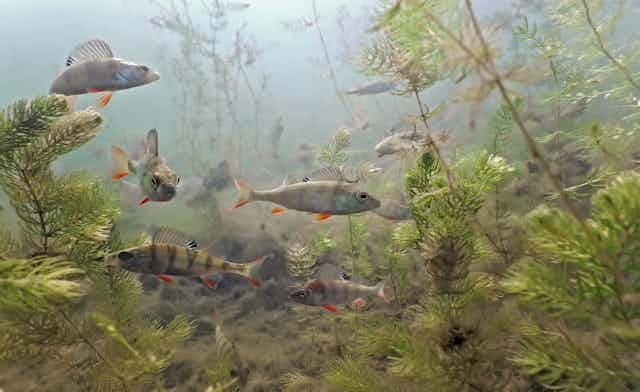Water may well be everywhere, but freshwater lake ecosystems are among some of the most vulnerable on Earth. In recent decades, freshwater species have suffered double the rate of decline of land species. And nearly 50% of fresh water lakes, rivers and streams across Europe failed to meet the EU Water Framework Directive, which aimed to achieve “good ecological status” of freshwater in Europe by 2015.
Part of the problem is that current tools used to monitor the so called “health” of a lake can be costly, time consuming, inefficient, and in some cases, lethal to the organisms they are sampling. Which is why our new research is pioneering a new way of monitoring water species – using techniques more familiar to fans of crime TV shows.
Environmental DNA, also known as eDNA works in the same way as regular DNA testing, but rather than using saliva or hair, samples of water, soil or even air are taken and tested. The method works because every creature in freshwater leaves behind traces of its eDNA as it swims around, shedding minute flakes of skin, eggs, sperm or in the case of plants, pollen or seeds.
The majority of eDNA studies so far have focused on detecting single species using highly specific DNA-based procedures which focus on detecting one species at a time. Our study instead used a form of DNA testing called “metabarcoding”. This is where a single region of DNA called a “barcode” is simultaneously sequenced from a whole community of organisms. This enabled us to analyse millions of DNA sequences from water samples, identifying the DNA of a broad range of species and looking at whole communities of organisms – rather than just detecting single species.
Metabarcoding of eDNA is a very new technology, and has only been tested in controlled conditions – such as in aquaria – or on a small scale in natural environments. But this technique has the potential to be a game changer for biodiversity monitoring, as it is completely non-invasive and extremely sensitive. It detects more species than established methods, and gives a surprisingly good indication of how abundant they are within the water environment.
DNA in action
We used this method of testing in Lake Windermere, England’s largest lake, to discover what fish species are living in the water and their relative abundance. And the information provided by these humble water samples exceeded all our expectations.
Windermere’s fish population has been monitored since the 1940s, by the Freshwater Biological Association and, more recently, the Centre for Ecology and Hydrology, using a combination of established fish survey methods such as netting, angler’s catches and hydroacoustics.
So to see how eDNA would compare to these established methods, earlier this year we braved all that the Lakeland weather could throw at us – from blizzards to glorious winter sunshine – to collect over 60, two-litre water samples – from the very northern tip to the southern tip of the lake.

The eDNA metabarcoding detected 14 of the 16 species ever recorded in Windermere – perch, roach, brown trout, pike, Arctic charr, bream and eel were the most common. Only the two rarest species, river and sea lamprey, were missed, but it is possible they are not present in the lake at the time of sampling. Whereas only four species were detected in the corresponding net survey.
Healthy lakes
Previous studies suggested that estimating how many fish are in an area of water from eDNA data would be problematic. Encouragingly though, our data indicated that eDNA may be better as measuring the quantity than previously thought. And we also found a clear pattern in the spatial distribution of eDNA in the lake.

Windermere is divided into two separate basins, the north and the south basin. With the South Basin more nutrient rich – also known as “eutrophic” – than the north. eDNA from species that don’t like nutrient rich conditions – such as Arctic charr – were found to be more common in the North Basin, while species that aren’t choosy were detected throughout the lake. This suggests that eDNA data could reliably indicate the ecological condition of lakes.
These results are a highly encouraging step towards eDNA becoming a game-changer in biodiversity monitoring. And we are now working closely with the Environment Agency and other groups to drive this research forward – to help ensure that the health our lakes is monitored in the most efficient and cost effective way possible.

